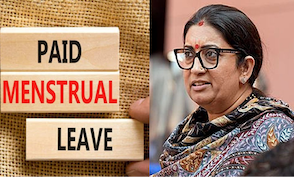Whenever I bought sanitary napkins without wrapping them in a newspaper or carrying them in a black polythene bag, I have been judged equally by both men and women. I have been looked at with disgust and unease as I openly carried my “Whisper” packets. This is the reality of India. The subject of ‘Paid menstrual leave’ is a long way off since the subject of ‘menstruation’ itself is still a taboo.
In common terms, menstruation is known as periods. It refers to a woman’s periodic cycle of bleeding from the vagina. If a person’s menstruation keeps them from working, they may be eligible for menstrual leave, which is a sort of paid time off from their job. India as a whole is against paid menstruation leave, having rejected a PIL on February 24, 2023, that sought menstrual pain leave. The court emphasized that the problem had a policy component that the Central government should be in charge of implementing. It was brought to light that menstrual pain leave had various “dimensions”, even though menstruation is a biological occurrence, taking such leave could potentially “discourage” employers from hiring women.
This case has been brought before the courts in the past. The Central and Delhi governments were directed by the Delhi High Court to hold a meeting in 2020 to deliberate on a proposal for paid menstrual leave, which would be available to all government employees, including those on the contract and also the daily paid employees. Nevertheless, in spite of these guidelines, the Central government has not yet made any significant strides toward establishing a national framework for paid menstruation leave.

However, many states, individually, have made efforts to get the policy implemented in their respective states but have failed in some way or the other way. Three attempts to introduce private member bills proposing menstruation leave have been attempted in the Lok Sabha.
The ‘Menstruation Benefits Bill 2017,’ proposed by Arunachal Pradesh Congress MP Ninong Ering at the time, was the first effort at this kind of legislation. It called for a four-day leave of absence during menstruation.
Following this, Congress MP of Tamil Nadu, M S Jothimani, introduced the ‘Right to Menstrual Hygiene and Paid Leave Bill 2019,’ in the Lower House. This bill suggested a right to a “paid leave” and an absence from work for three days during the menstrual cycle. Intending to “amend certain enactments to emphasize the agency of a woman for her sexual and reproductive rights and to guarantee menstrual equity for all women by the State.” Shashi Tharoor introduced the ‘Women’s Sexual, Reproductive, and Menstrual Rights Bill in 2018.’ It included a clause requiring authorities to supply sanitary napkins on their properties.
These bills were all introduced by members of ‘the House’ who are not ministers; that is why they are known as ‘Private members’ bills.’ Despite making these efforts the ‘Menstrual leave’ policy has not yet been discussed. But over time, MPs in the Lok Sabha and Rajya Sabha have brought up the topic in their queries.
Bihar and Kerala are the only two states in India to have implemented such policies for women. Under Lalu Prasad Yadav’s leadership, the Bihar government implemented a policy in 1992 that permitted female employees to use a maximum of two days of paid leave per month for reasons relating to menstruation. The purpose of this policy is to improve the mental and physical well-being of any female worker while lowering absenteeism and raising productivity. When the policy came up for discussion, some said that it perpetuated prejudices based on gender and might be used as a pretext for discrimination against female employees, while others felt that it was a positive step toward identifying and addressing the unique health requirements of female employees. The Purnea district of Bihar hosted the first Menstrual Hygiene Management (MHM) action plan introduction on March 8, 2022. The plan for 200 government high schools to receive awareness kits and MHM-friendly restrooms has been approved by NITI Aayog. Kerala has enacted similar laws, allowing female employees to take one day of menstruation leave per month, following in the footsteps of Bihar. Menstruation leave was made available to female students of all the State universities under the Department of Higher Education by the State administration. As stated on social media on January 19, 2023, by the Kerala Chief Minister Pinarayi Vijayan. The announcement was released shortly after the Cochin University of Science and Technology (CUSAT) decided to provide their female students with menstrual leave after receiving a representation from the students’ union. “Commitment to realizing a gender-just society” is how Vijayan characterized the government’s decision. A more extensive discussion ought to be started.
Moreover, the topic was very much under the cover for quite some time. It recently came up on December 13, 2023, when Smriti Irani, the leader of the Bharatiya Janata Party (BJP) and the Union Minister for Women and Child Development (WCD), spoke out against paid menstruation leave. Irani stated, “As a menstruating woman, menstruation and menstruation cycle is not a handicap, it’s a natural part of a woman’s life journey. We should not propose issues where women are denied equal opportunities just because somebody who does not menstruate has a particular viewpoint towards menstruation,” a warning that menstrual leave could result in discrimination against women in the working world. Irani did, however, declare that the Ministry of Health and Family Welfare was developing a National Policy and recognizing the importance of menstrual hygiene. This policy was developed in conjunction with stakeholders to raise National understanding and awareness of suitable management practices for menstrual hygiene.
The Union Minister also highlighted the ongoing ‘Promotion of Menstrual Hygiene Management (MHM)’ program, which aims to assist teenage girls from 10 years old to 19 years old age range. Through a range of teaching and awareness campaigns, this National Health Mission-funded program seeks to increase public understanding about menstrual hygiene. With such a controversial comment and opinion, Irani faced quite a lot of judgment and disapproval from many women in India, stating Irani to have been ignorant.

So why does India need a paid menstrual leave policy?
Ever since Spain became the first European country to implement paid menstrual leave, many other countries have been in a rush to follow their lead for the following reasons:
1. Menstruation-related conversations are frowned upon; thus, people may feel under pressure not to share their problems with coworkers. Menstrual leave may therefore offer the chance to discuss symptoms openly, which could neutralize or normalize the subject. Menstrual leave proponents argue that this would help de-stigmatize.
2. Menstrual leave is a useful tool for businesses to enhance the well-being of their female employees and advance gender equality.
3. Policies regarding menstruation leave vary among Nations and Businesses. For instance, certain rules allow for flexibility at work during menstruation, while others provide days off. If a policy allows for the latter, people can save their medical leave for illnesses other than menstrual disorders.
4. It provides the time needed to manage symptoms, get help, and heal before returning to work.
5. A person who has had enough sleep will also be more productive when they resume their work benefiting the company.
6. As an alternative, employers might help their staff members through difficult times by letting them work from the comfort of their homes and lowering their work hours. This makes it possible for individuals to work from home in a more comfortable setting with easy access to painkillers and warming packs.

Paid Menstrual Leave Implemented in the Indian Corporate World
While Smriti Irani disagrees with the paid menstrual leave, many Indian companies don’t think the same. A great example is that of Zomato. The Gurugram-based company, operating since 2008, implemented the policy way back in 2020. The company posted a blog explaining how it would apply the same from the 8th of August 2020, availing 10 days period leave per year for its women employees. The company wishes to provide a workplace that fosters a culture of trust and safety. Following the steps of Zomato, even Swiggy and Byjus were also seen implementing the same.
How is India better off the way it is right now?
While the policy spreads awareness and care towards a sensitive topic, it is also quite controversial. India could face the following potential risks if they execute the same:
1. Conversations regarding menstruation at work go against societal norms that encourage secrecy. As a result, some think that increased transparency can reinforce stigma rather than help to eliminate it. Menstruation is often a private matter, thus mentions of it in public places like – the workplace, may offend some individuals.
2. Professor of Epidemiology and Global Public Health at the University of Michigan School of Public Health, Ann Arbor, Sioban Harlow, Ph.D., has written extensively about the history of stigma associated with menstruation at the workplace. According to Harlow, beliefs that women are less productive at work may arise from the prevalent use of period leave. Menstrual leave is officially defined, and if a woman’s coworkers know she is taking it, Harlow observes, she may face discrimination in promotions and performance assessments.
3. Likewise, Dr. Feinberg notes that people who do not menstruate may find themselves in an awkward situation if the majority of the women in their workplace begin to take their period leave. Women who experience early menopause or who identify as transgender may face unwanted attention or queries from coworkers that compel them to divulge personal information.
The topic of menstruation, even in the 21st century, remains sensitive in India. A very small population of India seems to have accepted to normalize it and work in favor of spreading awareness for the same. Hence, while many companies and some states are working towards the policy, it will take us, a lot of time to accept this concept and then work towards a leave policy.
Written by – Senghani Shree
Edited by – Mrunmayee Patwardhan
